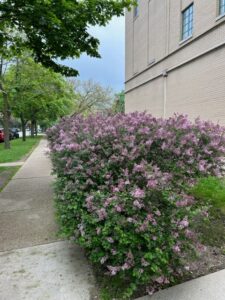Evanston RoundTable, May 24, 2023
Bitter cold winters seem to be shrinking, getting warmer and less burdened with snow, dreary as ever but a pale reflection of the fierce winters of half a century ago, which was the subject of my last column.
This year’s usually splendid spring season seems to have shrunk too, a few nice days mixed in with weeks of rain, gray skies and cool temps, threatening to bleed directly from drab winter to a blazing Chicago summer without so much as a proper how de do.
Then there is lilac season. It lasts just a few weeks – but how the lilacs sanctify and endow this time of year with their sublime beauty and rich aroma!

“In the dooryard fronting an old farm-house near the white-wash’d palings,
Stands the lilac-bush tall-growing with heart-shaped leaves of rich green,
With many a pointed blossom rising delicate, with the perfume strong I love,
With every leaf a miracle – and from this bush in the dooryard,
With delicate-color’d blossoms and heart-shaped leaves of rich green,
A sprig with its flower I break.”
T.S. Eliot famously opens The Waste Land with “April is the cruelest month, breeding lilacs out of the dead land…” Even the cruelty of a cold Midwestern spring (which Eliot must have known well: he grew up, after all, in St. Louis) can’t stifle the primitive force that propels lilacs through the winter-encrusted soil and acts “as a reminder of memory and love, while spring rain stirs up the painful past,” according to an analysis by LitCharts.
The 19th century Russian author Ivan Turgenev writes in Fathers and Children (formerly known as Fathers and Sons), of “great bunches of lilacs’” arranged beside the bubbling samovar, which sets up an important scene in the novel.
“Proust evoked [lilies] in his long memories and valued them as oriental and opulent, and observed accurately the heart-shaped beauty of their young leaves,” states an article in the Financial Times, which also notes that Chekov, “the keenest of gardeners,” mentions lilacs throughout his short stories.
And here’s a poetic ode from children’s author Elizabeth Gordon’s delightful Flower Children:
Lilac wears a purple plume,
Scented with a sweet perfume;
Very high-born lady she,
Quite proud of her family tree.
In her short story Lilacs, Kate Chopin conflates the smell of lilacs with happiness and contentment, writing, “When the scent of the lilac blossoms began to permeate the air, Sister Agathe would turn many times during the day to the window; upon her face the happy, beatific expression with which pure and simple souls watch for the coming of those they love.”
Lilacs also have a centuries-old place in American history. The Arnold Arboretum in Boston, which has more than 400 lilac shrubs on display, notes that in 1767 “Thomas Jefferson recorded his method of planting lilacs in his Garden Book, and on March 3, 1785, George Washington noted that he had transplanted existing lilacs in his garden. The oldest living lilacs in North America may be those at the Governor Wentworth estate in Portsmouth, N.H., believed to have been planted around 1750.”
From Better Homes and Gardens, a few fun facts about our favorite spring bloom:
1. Lilacs are in the same family as the olive tree: They belong to the Oleaceae family, which includes over 20 different plant species, including olives, ash and jasmine.
2. Lilacs are rooted in Greek myth: For the ancient Greeks, lilacs were an integral part of the story of Pan, the god of forests and fields. It was said that Pan was in love with a nymph named Syringa. As he was chasing her through the forest one day, she turned herself into a lilac shrub to disguise herself because she was afraid of him. Pan found the shrub and used part of it to create the first panpipe.
3. Lilacs have different meanings in different cultures: The Celtics saw lilacs as magical because of their sweet scent. During the Victorian age, lilacs were a symbol of an old love – widows often wore lilacs during this time. In Russia, holding a sprig of lilac over a newborn baby was thought to bring wisdom.
4. Each lilac color has a different meaning: Although the species stands for renewal and confidence overall, each color of lilac has its own specific meaning. White lilacs represent purity and innocence, while purple lilacs symbolize spirituality. If the blooms edge more on the blue side of the color wheel, they symbolize happiness and tranquility. Magenta lilacs symbolize love and passion.
5. Lilacs can be relics of old homes: Lilacs are known for their hardy nature and long lives – many lilac shrubs live to be more than 100 years old. Because of their life span, they often survive longer than the home of the gardener that planted them. So, if you’re on a country road and see a few seemingly random lilac bushes, there was most likely a house or farm there in the last century.
And from the Chicago Botanic Garden, we learn there are more than 2,000 varieties of lilac “blooming from as early as the second week of May through mid-June.”
So we are blessed this year with the early arrival of the heavenly lilac season, and if the cool night air and crisp mornings persist, we should see them in full bloom and scent a few more weeks. Take heed, Evanstonians, and seek them out: lilacs are one of the great wonders of nature and their annual arrival here, brief as it is, is a delightful span of time, splendor and weather.

So interesting Lester. As always, the devil is in the details.
I miss the midwest Lilca, here in Northern CA!